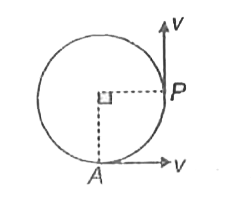A particle of mass is moving in one dimension under a force that delivers constant power to the particle. If the initial speed (in ) after is.
The correct Answer is:
.
Topper's Solved these Questions
Similar Questions
A particle of mass 0.2 kg is moving is one dimension under a force that delever is a constant preses 0.5W in the particle . If the detail speed (nms−1) of the particle is zero , the speed(mms−1) after 5× is
View SolutionA particie of mass 10 kg is driven by a machine that delivers a constant power of 20 watts. If particle starts from rest and moves along a straight line, then force (in Newton) on particle at time t(t>0) is
View Solution
Knowledge Check
- Question 1 - Select One
A particle of mass m is driven by a machine that delivers a constant power k watts. If the particle starts from rest the force on the particle at time t is
A(√mk2)t−12B(√mk)t−12C(√2mk)t−12D(12√mk)t−12 - Question 2 - Select One
A particle of mass m is driven by a machine that delivers a constant power k watts. If the partilcle starts from rest the force on the particle at time t is
A√2mkt−1/2B12√mkt−1/2C√mk2t−1/2D√mkt−1/2 - Question 3 - Select One
A particle of mass 10 kg is driven by a machine that delivers a constant power of 20 watts. If particle starts from rest and moves along a straight line, then force (in Newton) on particle at time t(t>0) is
A10√tB10√tC20√tD1√t
A particle of mass 2 kg is moving in circular path with constant speed 20 m/s. The magnitude of change in velocity when particle travels from A to P will be
 View Solution
View SolutionA body of mass 10 kg is being acted upon by a force 3t2 and an opposing constant force of 32 N. The initial speed is 10ms−1.The velocity of body after 5 s is
View SolutionThe displacement x of a particle of mass 1.0 kg moving the one dimension under the action of a force is related to time t by the equation t=√x+5 where x is in meter and t is in second. The magnitude of the momentum of the particle
View SolutionA particle of mass m moves in a circular path of radius r, under the action of force which delivers it constant power p and increases its speed. The angular acceleration of particle at time (t) is proportional
View SolutionThe displacement 'x' (in meter) of a particle of mass 'm' (in kg) moving in one dimension under the action of a force is released to time 't' (in sec) by t=√x+3. The displacement of the particle when its velocity is zero will be.
View Solution

